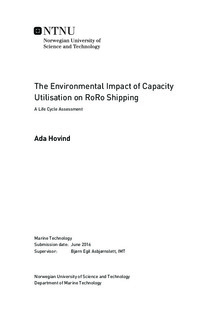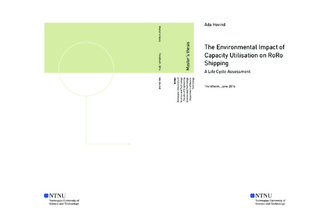| dc.description.abstract | The focus on reducing global emissions has increased over the last decades, and has resulted in stricter environmental requirements for the shipping industry. New regulations focus on reducing the pollution of ships to sea and air. This is done through limiting CO2, NOx, and SOx emissions, and reducing the transfer of ballast water from one part of the world to another, to mention a few. However, the environmental impact of a vessel does not only include the operational phase. The emissions begin with the materials production, fuel refinement and energy production before the vessel is even built, and continues throughout its entire life cycle. Many ship owners have taken action to reduce pollution by changing fuel in emission control areas (ECAs), using emission reduction technology or build larger vessels. In theory, a larger vessel is more energy effective, and cost effective, per unit of cargo transported.
The main object of this thesis was to investigate the impact of utilisation on the environmental performance of RoRo vessels. This was done to determine if using larger vessels is the most energy effective overall, or if smaller vessels are a better choice when the utilisation decreases. A life cycle assessment (LCA) was performed to map the environmental impact of five RoRo vessels, with varying cargo capacity. The environmental impact categories selected for the LCA were climate change, human toxicity and terrestrial acidification. These were chosen due to a concern for global warming, and the local impact of shipping on human health and acidification.
The case study included five RoRo vessels, with a capacity of 2,000, 4,000, 6,000, 8,000 and 10,000 RT. A cradle-to-gate assessment was used for the LCA, including the building phase, operational phase, dry-docking and scrapping phase of the vessels, as well as the process of material production, fuel refining and more. The operational pattern was assumed equal for all vessels, with 75% sailing time and 25% port-stay. The results from the assessment were given as emissions per vessel per year, in order to compare the performance of the different vessels.
To calculate the relationship between emissions and utilisation, the results from the LCA were used. The calculations were performed to represent emissions per RT, a standard car unit, nautical mile for different utilisation factors. Three different results were presented; the comparison of the five vessel sizes, the comparison of five fleets, and the comparison of emissions when transporting a specific amount of cargo. For the fleet perspective, homogenous fleets were used, and it was assumed that all fleets should transport 200,000 cars per year. As a result of this, the amount of vessels varied from 20 for the fleet of 10,000 RT vessels, to 100 for the fleet of 2,000 RT vessels. In addition to the emission-utilisation calculations, a cost-utilisation analysis was performed. This was included because cost is the most important decision making criteria in shipping, and it was interesting to see how the cost reacted to variations in utilisation.
The results from the LCA showed that the operational phase had the largest impact on climate change and terrestrial acidification, while the building phase had the largest impact on human toxicity. At the 100% emissions baseline (6,000 RT, 95% utilisation), the 10,000 RT vessel obtained the lowest emissions per RT nm. The 6,000, 8,000 and 10,000 RT vessels need a utilisation rate of 95%, 93% and 81% respectively, to achieve the same emissions per RT nm for climate change. The results varied a few percent for the human toxicity and terrestrial acidification, but the trends were the same. The cost-utilisation analysis showed that the largest vessel would give the lowest required freight rate with a utilisation of 80% or higher.
For the fleet perspective, the fleet with 2,000 RT vessels obtained the lowest emissions, while the fleet with 10,000 RT vessels gave the highest emissions per RT nm. The reason for the opposite results is the sailing distance. The sailing distance for the fleets with small vessels is much larger because there are many more vessels. If the results were presented as emission per RT, the 10,000 RT fleet would again be the most sustainable, down to 85% utilisation. The results giving emissions for a specific amount of cargo showed that when a vessel is fully loaded, it is the best choice, however, when additional cargo is added, the emissions increase drastically because another vessel has to be used.
Based on the results from the LCA and the utilisation calculations, it is concluded that utilisation has an impact on the environmental performance of a vessel, and that the largest vessels are not the most sustainable for all utilisation factors. The largest vessels, when looking at emissions per RT nm for a one vessel perspective and emission per RT for the fleet perspective, can sail with lower utilisation, and still achieve the same emission levels per transport work, or per car, as the smaller vessels. However, it is important to notice that the large vessels have to transport more cargo at lower utilisation rate, and they are therefore dependent on large enough cargo base. This means that the advantage only can be realized in major shipping trade lanes, e.g. Asia to Europe, but not North America to the West Coast of South America. | |

